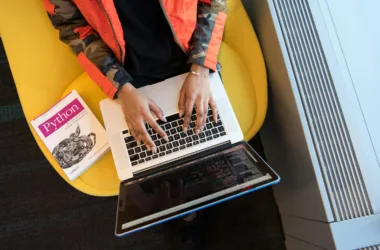Ever thought about how interview prep changes for onsite vs. remote ones? It’s an important question today.
The way we interview is shifting fast after the pandemic. It’s key to know the difference between onsite and remote interviews. Now, 41% of hiring managers use both onsite and remote interviews. And, 23% are switching to just remote interviews. Even big companies like Microsoft are hosting more virtual events, up to 35 a month.
Getting ready for any interview type is crucial. Whether it’s a remote or onsite interview, the right preparation helps you shine. It’s what can get you the job in the end.
Understanding the Shift to Remote Interviews
The switch to remote job interviews has majorly changed how companies hire. Because of COVID-19, virtual interviews became essential for lots of companies. This change is likely to stay, with companies mixing both virtual and onsite interviews.
The Rise of Virtual Job Interviews
The growth of virtual interviews happened for many reasons. In 2021, 82% of employers said they used remote interviews. These interviews are easier to schedule and let companies meet candidates from everywhere.
About 93% of employers plan to keep using virtual interviews after the pandemic. This shows how companies value the ease and broad reach of online interviews.
Statistics on Current Hiring Practices
Around 39% of companies worldwide now prefer doing interviews remotely. This allows them to find candidates from anywhere, without limits. But, there are hurdles, like connection issues or the need for technology such as webcams.
Despite challenges, online interviews help companies assess candidates fairly. It’s important for candidates to be professional and clear. This leads to good communication and leaves a positive impression.
Key Differences Between Onsite and Remote Interviews
Onsite and remote interviews each have unique aspects. These aspects are crucial for evaluating candidates well. Cultural differences matter a lot in these settings. They affect how candidates are seen and how they present themselves.
Each method, whether onsite or remote, has its strengths and challenges. These influence how companies choose their potential employees.
Cultural Dynamics in Different Settings
In-person meetings during onsite interviews help form closer connections. This is especially important for jobs needing strong personal skills. Onsite interviews let us see a candidate’s body language better. This helps in understanding them more fully.
In remote interviews, it’s harder to feel that personal connection. Cultural differences also play a role here. They influence how candidates answer questions and how we interpret their actions.
Evaluation of Candidates: Virtual vs. In-Person
Remote interviews often use online tests, take-home assignments, and video calls. These tools help companies screen candidates early on. However, onsite interviews include more people in the evaluation. This helps in a better assessment of the candidate.
Remote interviews can face technical problems, affecting the overall process. But onsite interviews help clarify any doubts and sell the job well. A standardized process is important. It makes sure all candidates are treated fairly, whether interviewed onsite or remotely.
Preparing for a Remote Interview
The move to virtual hiring requires candidates to get ready for remote interviews. It’s key to set up a strong interview area for a good result. Pick a place that’s quiet with no distractions to perform your best.
Creating an Optimal Interview Space
Having a professional environment helps candidates stand out. A special workspace boosts focus and looks professional. To make the perfect interview area, you should:
- Choose a spot that’s bright and quiet.
- Keep pets, phone pings, and mess away.
- Make sure your background looks neat and professional.
Testing Your Technology and Equipment
It’s key to check all your tech before the interview. This makes sure everything works smoothly. You should:
- Test your sound and video with apps like Zoom, Teams, or Google Meet.
- Learn how to use the platform you’ll be on.
- Do a practice run at least ten minutes early to find any tech problems.
These steps help you feel calm about your tech, letting you chat more easily.
Dressing for Success from Home
Wearing the right clothes for a remote interview is still important, even at home. The right outfit boosts your confidence and shows you respect the interview. Remember these tips:
- Dress like you would for an in-person job in your field.
- Look sharp, even if it’s just a phone interview.
- Think about what your clothes and setting tell the interviewer.
With careful preparation, candidates can approach remote interviews with confidence and professionalism.
Preparing for an Onsite Interview
Getting ready for an onsite interview takes thoughtful planning and effort. You need to handle the logistics well to show you’re serious. Make sure you plan your travel well to be on time, even if delays pop up. Being on time shows you respect the people you’re meeting with.
Logistics: Travel and Timing Considerations
It’s key to plan your travel smartly for onsite interviews. You should:
- Figure out the best way to get there, thinking about traffic.
- Keep in mind things like construction or issues with public transport.
- Try to arrive at least 15 minutes early for any surprises.
Being punctual helps make a good first impression. Careful planning can prevent last-minute problems.
Establishing Rapport with Interviewers
It’s important to connect well with your interviewers in person. You can make a good atmosphere by engaging well with them. Here are some tips:
- Start with light conversation before the formal part.
- Show you’re really excited about the job and the company.
- Use body language and eye contact to strengthen your connection.
Showing your interest in the role and the people interviewing you helps. It makes for better talks and boosts your chances of doing well.
The Importance of Research Before the Interview
Doing your homework about a company is key for a great job interview. Knowing what a company believes in helps you talk deeply with them. You’ll be ready to highlight what makes the company stand out.
Understanding the Company’s Mission and Values
Getting to know a company’s goals and what they value is smart. It shows how your past work fits with what they want to achieve. Checking out financial details on the company’s website under “Investor Relations” is a good move. It gives a peek into their financial state and goals.
Utilizing Platforms like Glassdoor and LinkedIn
Platforms like Glassdoor and LinkedIn are gold mines for info. Glassdoor reviews let you feel out the company vibe. It’s important to look at both good and bad feedback. Knowing about competitors and industry trends can make you seem more skilled and adaptable during your interview.
Behavioral and Technical Questions for Both Interviews
Getting ready for interviews means knowing specific questions you might be asked. Remote position candidates should prepare for various questions. These evaluate both their technical skills and behavioral traits. Companies use these to see if an applicant would fit well in their team.
Common Questions Faced in Remote Interviews
Questions in remote interviews are mainly of two types: behavioral and technical. Behavioral questions explore a candidate’s past actions and values. They often cover topics such as:
- Teamwork
- Customer service
- Adaptability
- Time management
- Communication
- Motivation and values
To answer effectively, candidates should employ the STAR method. This means discussing the situation, task, action, and result. Using clear examples from past work enhances your answers. For technical side, be ready for questions specific to your role that test your knowledge and how you solve problems.
Expectations for Onsite Technical Assessments
Onsite technical assessments have their own set of expectations. Participants may need to perform tasks that show their skills in action. These tests often depend on the job role and can involve:
- Code challenges for developers
- Design tasks for architects
- Case studies for project managers
Doing well in these assessments requires technical know-how and clarity in explaining your thoughts. Unlike remote interviews, in-person ones allow for direct interaction. This lets candidates show their teamwork skills and get feedback right away.
Body Language and Communication Skills
In both onsite and remote interviews, knowing how to use body language is key. How you use gestures, posture, and your presence can change the interview’s outcome. Studies show that up to 55% of what we communicate comes from these nonverbal cues. In person, good body language helps build a strong connection with the interviewer.
Interpreting Body Language during Onsite Interviews
It’s important to watch body language during onsite interviews. A strong handshake matters a lot. It’s been found that 70% of people could get turned down for giving weak handshakes. Eye contact is just as crucial. It makes you seem more trustworthy and credible. In these settings, 65-70% of what’s communicated is through body language. Candidates should:
- Keep a good posture to make a positive first impression, boosting their chances by up to 80%.
- Smile genuinely to come across as likable and competent.
- Gesture in ways that show they’re engaged but without overdoing it.
- Nod at the right times and mimic the interviewer’s posture to connect better.
The Role of Virtual Presence in Remote Interviews
Your virtual presence is crucial in remote interviews. You should show excitement through video and positive facial expressions. Looking directly at the camera helps mimic eye contact. This is about 50% of the impression you make. Sitting up straight is vital too; slouching might show a lack of interest. Also, having a tidy background helps keep the focus on you. Tips to improve your virtual presence include:
- Dress professionally, even if you are at home.
- Use breathing techniques to calm nerves and appear more confident.
- Speak clearly and confidently to improve how you communicate.
- Remember to nod and lean in a bit when listening to show you’re engaged.
Practice Makes Perfect: Mock Interviews
Mock interviews are key for interview prep, whether they’re online or face-to-face. They help people get better at answering questions and become more ready for the real thing. Through virtual practice, you can get used to video technology and sharpen your interview skills.
Benefits of Mock Interviews for Remote Settings
Virtual mock interviews have lots of benefits for those looking for jobs. They let you rehearse answers to questions recruiters, like those from Verizon, might ask. This improves how you perform. Checking your tech ensures your real interviews won’t have technical problems. It’s also a good time to turn off things that could distract you, like phone alerts. This helps you stay focused.
The Value of In-Person Mock Interviews
In-person mock interviews let you get instant feedback from people you know or mentors. Meeting face-to-face lets you see how well you communicate and present yourself, which is vital for onsite interviews. How you dress, including socks and shoes, really matters. It affects what interviewers think of you. Candidates, including Filipe Gonçalves, Ricardo Canales, and Sherzat Aitbayev, found mock interviews boosted their confidence. It even helped them get job offers from top tech companies.
Follow-Up Etiquette After the Interview
Following up after interviews is vital. A thoughtful thank you note can make you stand out. It shows professionalism and interest, whether the interview was remote or onsite.
Crafting a Thank You Email for Remote Interviews
For remote interviews, it’s crucial to send a concise thank you email within 24 hours. This keeps you in the interviewer’s mind. A good follow-up email should:
- Begin with a brief expression of gratitude.
- Refer to specific moments from the interview to personalize the note.
- Concisely reiterate your enthusiasm for the role.
- Maintain a professional tone and avoid excessive punctuation.
Add relevant information, like articles or work samples discussed during the interview. This personal touch can help you stand out.
Following Up Post-Onsite Interview
The same goes for onsite interviews. Sending a thank you on the same day is key. This helps solidify the connection made during the interview. Summarize key points and reaffirm your interest in the role and company. Follow these tips:
- Sending a follow-up email four to five business days after the interview.
- Staying concise with only a couple of sentences or a paragraph.
- Including expressions of interest in the position and appreciation for the opportunity.
By following these steps, your follow-up will leave a positive impression. In a competitive job market, maintaining a good relationship with your interviewer is crucial.
Potential Challenges of Remote Interviews
Remote interviews bring challenges that can mess up the experience. It’s important for candidates to know these obstacles when preparing. Learning about technical issues and background bias helps increase success chances in virtual interviews.
Technical Glitches and Connectivity Issues
Technical problems are common in remote interviews. Poor internet can block good communication, hurting the interview. Not seeing visual cues makes it harder to read body language. This increases stress that could change how well a candidate does. To solve these problems:
- Check your tech works fine before the interview.
- Have a backup plan ready in case your internet fails.
- Think about using online tools for tech tests, to make things smoother despite tech troubles.
Addressing Background Bias in Virtual Settings
Background bias can unfairly judge candidates in remote interviews. Interviewers might make assumptions based on a candidate’s background, which doesn’t show true skills. It’s crucial to have a professional setting to avoid distractions and make a good impression. To fight background bias:
- Make a neat, distraction-free area for your interview.
- Use features to blur or switch your video background if needed.
- Focus on talking about your skills and qualifications to keep the interviewer’s attention on what matters.
Conclusion
Getting ready for interviews is crucial, especially with the rise of remote interviews. Changes in hiring, sparked by global events, make remote meetings common. Job seekers need to prep for both in-person and remote interviews. It’s important to show you’re a top choice no matter what.
To succeed, start with good prep. Learn about the company and practice your interview at home. You should research, practice answering questions, and think of your own questions. This shows your interest and makes a personal connection.
Whether it’s on a video call or face-to-face, thorough preparation matters. Showing you understand both interview types and acting professionally will impress. Go into your interview ready and let your hard work stand out.






